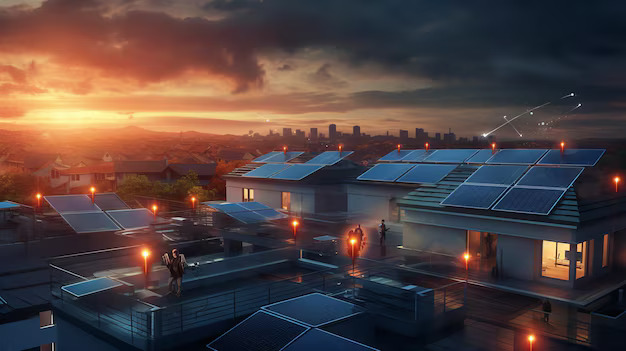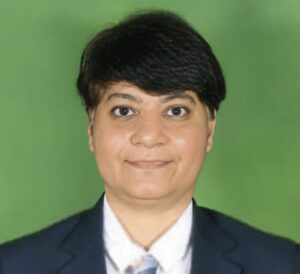Research Objectives
To explore ways in which amalgamation of technologies can bring digitization of the traditional grid.
Keywords
AI, Covid-19, Sustainable, Electricity, Smart Grid.
Bio
Leena Patel is Founder and CEO of Global entrepreneurial system GES one soul army certified by CERN & NASA. She is from Ahmedabad, Gujarat, India. Leena Patel’s hard work and dedication had resulted in being awarded 19 International Awards and several Titles. In addition, Leena Patel is a Brand Ambassador at 4 International/ National Associations, and she is a World Record Holder for being an EDUCATOR & EDUPRENEUR.
Abstract
The global coronavirus (covid-19) pandemic resulted in humans taking a pause from their mundane lives. It has facilitated individuals to act in retrospect and react thoughtfully to the new normal way of living on earth. In addition, they have started to think about how to share common resources due to the rise in cost of living. Electricity has played an important role in fueling industrial, commercial, and household appliances. Simultaneously, it has contributed to the running of technology, social media, and communication equipment, which was highlighted during the lockdown period, as it was utilized to keep humans informed and connected. Not all energy generation techniques are sustainable, resources such as natural gasses, coal, and nuclear resources used in electricity generation are limited. Therefore, finding sustainable alternatives for electricity generation, will help humanity greatly in future events like covid-19 pandemic. In conclusion, this work presents a cumulative analysis of sustainable alternatives through which electricity generation can occur, highlighting limitations and presenting novel AI-driven approaches to conserve different forms of renewable energy and use them to generate electricity. Ultimately, we all look for the innovative dimensions of life-standard, to achieve and aspire with the goals of 5th industry revolution as well in the future.
Introduction
Fulfilling demands of electricity has always been a challenge for several developing countries. This has become more complex and difficult as pandemic has created a great impact on communities, including the use of electricity patterns in our day-to- day life. As per a study conducted by Abdeen, Kharvari, O’Brein and Gunaya (Abdeen, Kharvari, O’Brien, & Gunay, 2021), a few areas in Canada have increased significantly heightening from 16.3% to 29.1% every day after COVID-19. Such trends have been observed by major distributors across the globe and have resulted in emergence of newer ways of electricity generation (Abdeen, Kharvari, O’Brien, & Gunay, 2021) to cope with the rise in demand. Global push towards reducing carbon emissions resulting from using traditional fossil fuels for electricity generation has drawn significant attention towards renewable energy resources such as wind power, solar energy, hydropower, tidal energy, hydrogen etc. as an alternative means to generate electricity. Despite having numerous benefits – never ending & replenished time to time; one time cost of installing needed machineries; less maintenance; promote well-being of remote areas as chances of generating renewable energy are higher over such regions; capacity of recycling waste in the form of biomass energy; lesser reliance on imported energy – of renewable sources, integration of renewable energy into electric grid is facing challenges mainly due to their variable and uncertain nature (Shi, et al., 2020).
Uncontrollable power output generated from Variable Renewable Energy (VREs) (IRENA, 2019) has necessitated the initiation of novel methods of energy storage and dispatching energy to the grid later to handle peak load duration (Shi, et al., 2020). Also in the traditional grid structure, the transmission and generation are the dominant elements which are monitored in real-time and controlled. This is due to the fact that there are numerous unauthorized “connections to the power grid”. This indicates colossal energy is not being accounted for through meter readings with financial implications (Shi, et al., 2020). This contributes to a major challenge due to heightened CO2 emissions, decreased efficiency and increase financial investment to help find solutions. To integrate these VREs and overcome limitations of electric grid structures, many developed countries have started investing in a new version of grid – “Smart Grid” (Shi, et al., 2020).
The Smart Grid is defined as “an electric system that uses information, two-way, cyber-secure communication technologies, and computational intelligence in an integrated fashion across electricity generation, transmission, substations, distribution and consumption to achieve a system that is clean, safe, secure, reliable, resilient, efficient and sustainable” (Shi, et al., 2020). The characteristics of smart grid mentioned in below figure require installation of new devices at each stage of grid – Smart Meter & Home Area Networks, Photovoltaics, Electric vehicle Charging Stations & Micro grids, Newer means of energy storage, Heat & Power Co-Gen Facilities, Solar Thermal & Wind Farm Generation, etc. (Shi, et al., 2020).
Smart meter can be perceived as a heterogeneous that measures electricity which is inputted into a grid. There are multiple benefits of such an advanced energy system and users. Using smart meters, the major issues like unjustifiable bills, back billing etc. can be resolved because of the advantages of measurement accuracy. It provides the profits including the lowest and precise measurements of the energy use at regular intervals. The financial commitments only pertain to energy utilized. Also, the smart meters are
- Vast amount of data generated due to use of IoT- empowered smart meters (IRENA, 2019), replacement of traditional SCADA systems by Phasor Measurement Units (PMUs), smart home appliances,
- Decentralization with increased deployment of small renewable power generations
- Added demands of electricity load i.e. electric vehicles, boilers, etc.
- Intermittent & discontinuous nature of renewable energy resources (particularly wind & solar)
- Bi-directional flow of electricity has enabled new challenges to ensure smooth operation.
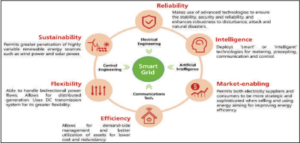
Figure 1 (shi, et, al., 2020)

Figure 2 (IRENA, 2019)
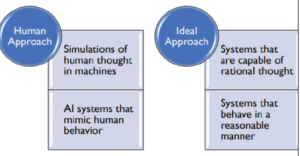
Figure 3. (Mhlanga, 2006)
(IRENA, 2019) presents how technologies like, Artificial Intelligence and Big Data, Internet of Things (IoT) and Blockchain. When used together might result in powerful tools to deal with complexity introduced because of the above factors (IRENA, 2019), (Ahmad, et al., 2022) represent this amalgamation of technologies that can significantly contribute to the modern power sector at different stages of the energy industry i.e. the production of electricity, delivering power, storing energy and electric distribution networks.
Artificial intelligence and machine learning can facilitate optimum generation of power. Figure 3 demonstrates how applying AI and ML within energy sectors can be advantageous within countries like Africa. According to figure 4 some solutions include “performing predictive maintenance of turbines, the ability to accurately predict energy prices, AI and ML to correctly determine energy demand” (Mhlanga, 2006).
This paper presents a survey on three major key points on the effectiveness of AI algorithms in ensuring stability and reliability of the power grid. Those key points are mentioned and discussed in the next chapter.
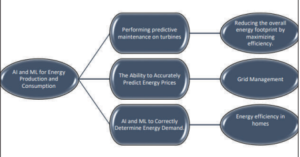
Figure 4. (Mhlanga, 2006)
2 Role of Technology in Integration of Variable Renewable Energy (VREs) into Power System:
This chapter presents a few key points of review done on effectiveness of AI algorithms in ensuring stability and reliability of power grid by:
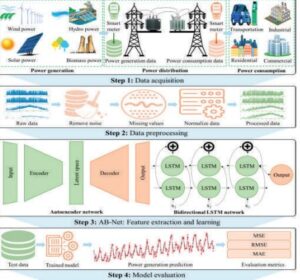
Figure 5. (Ahmad, et al., 2022)
Accurately forecasting renewable energy generation
It helps in safe grid operation & minimizes the operational cost of energy sources (Ahmad, et al., 2022). In addition, “AB-Net” is a new architecture that is formed pertaining to a forecast consisting on one step toward regenerating for horizons in the short-term. This can be achieved through integrating an autoencoder (AE) together with a bidirectional long short-term memory (BiLSTM).
According to this research done by researchers of Sejong University of Korea, to solve the forecast problem a new architectural development was made. It ensures that a hybrid connection is initiated between the BiLSTM network and AE. The process entails data clearance through refinement and preprocessing. Feature collection is conducted through the refined sequence as it is processed to the AE. The featured attained from the AE are then provided to the BiLSTM so the concluding forecast can be attained. RES power can be forecasted accurately through this process because this proposed approach can learn compressed representation from the sequential input data. The method that has been proposed will facilitate the avoidance of wasting energy production via reducing the production of excess energy power. The algorithm that has been proposed will aid smoother cooperation between the smart grid and the consumers. Through utilizing data that is available on the public domain, there was an increase in performance levels in comparison to other techniques. Figure 5 highlights the framework of the architecture proposed.
Incorporating predictive maintenance
The maintenance and deterioration of a turbine can be accurately predicted via analytics. This can be achieved through sensor data recorded from a wind turbine (Xu, Pan, Chen, & Fu, 2019).
This paper (Rodriguez, et al., 2023) talks about three types of maintenance as below:
- Corrective
- Preventive
- Predictive
In Corrective maintenance when the product was damaged then and only maintenance was performed so it is already prompted that seems such an inefficient way to apply. Corrective maintenance is not that much effective so preventive maintenance and predictive maintenance are widely used and because of that both are popular too. The feasible way to perform the maintenance is between two strategies, proactive and reactive is known as condition-based maintenance (CBM). It is focused on constant monitoring and prior to any failures happening they are detected by condition monitoring systems (CMS). This is achieved through obtaining data from sensors which is then pre-processed, after which data is evaluated and interpreted. The predictive maintenance can also be referred to as proactive maintenance. There are three types of predictive maintenance observed with real time data to be or not: “1. Based on existing sensors 2. Based on Supply sensors 3. Based on signal techniques” (Rodriguez, et al., 2023). When predictive maintenance is applied it subsequently links to the big data paradigm. This then deals with the data
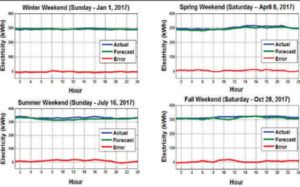
Figure 6 (Eseye, Lehtonen, Tukia, Uimonen & Millar, 2019)
management methods which include the Cross Industry Standard Process for Data Mining (CRISP-DM), Sampling, then exploration, modification, modelling and accessibility processes are followed after which the Team Data Science Process (TDSP) is completed (Rodriguez, et al., 2023).
Predicting consumer demands
It talks about effective application of Genetic Algorithm (GA) in forecasting the demand for electricity within smaller decentralized energy systems that are being initiated in smart grids (Khan, et al., 2021).
BINARY GENETIC ALGORITHM (BGA)
The theory of evolution and genetics by Charles Darwin has inspired the GA population-based heuristic type optimization method. It is based upon the survival of the fittest (Eseye, Lehtonen, Tukia, Uimonen, & Millar, 2019).
FS RESULTS EVALUATION: IMPROVED FORECASTING
As per the forecast results of Feature Selection approach in Figure 6, the model testing has been completed on a randomized selection of dates. This included the following: during the summertime Wednesday 26th July, 2017, summer weekend Sunday 16th July 2017, a fall weekend included Thursday 12th October,2017, another fall weekend Sunday 1st January 2017, a Spring weekend included Tuesday 18th April 2017 and another Spring weekend selected was Saturday 8th April 2017. Information gathered from these dates highlighted the importance of forecasting models in ensuring the optimal quality of the energy is supplied but at a low cost. Figure 6 highlights Machine Learning Based Integrated Feature Selection Approach for Improved Electricity Demand Forecasting in Decentralized Energy Systems.
Conclusion
This paper has explored ways in which amalgamation of technologies can bring digitization of traditional grid. When combined machine learning & Internet of Things with smart grid, it will result in better analysis and tighter control at all the stages of the energy sector from power generation to power distribution. Also, the goal of this research was to make the energy industry realize the possible contributions of AI and machine learning ML technologies. This may help to develop future advancements and tools with the formulation of small-scale decentralized systems for the growing nations across the globe.
Funding: This research received no external funding.
Data Availability Statement: We have done a survey on the researched data for the research paper title.
Conflicts of Interest: Author declares no conflict of interest.
References
Abdeen, A., Kharvari, F., O’Brien, W., & Gunay, B. (2021). The impact of the COVID-19 on households’ hourly electricity consumption in Canada. Energy and buildings, 250.
Ahmad, T., Hongyu, Z., Dongdong, Z., Rasikh, T., Bassam, A., Ullah, F., . . . Sultan, A. (2022). Energetics Systems and artificial intelligence: . Applications of industry 4.0. Energy Reports.
Eseye, A. T., Lehtonen, M.,Tukia, T., Uimonen, S., & Millar, R. J. (2019). Machine Learning Based Integrated Feature Selection Approach for Improved Electricity Demand Forecasting in Decentralized Energy Systems. IEEE Access, 13.
IRENA. (2019). Artificial intelligence and big data innovation landscape brief. Irea , 1–24.
Khan, N., Ullah, F. U., Haq, I. U., Khan, S. U., Lee, M. Y., & Baik, S.W.(2021). AB-Net: A Novel Deep Learning Assisted Framework for Renewable Energy Generation Forecasting. Mathematics, 2456.
Mhlanga, D. (2006). Artificial Intelligence and Machine Learning for Energy Consumption and Production in Emerging Markets. Johannesburg: The University of Johannesburg.
Rodriguez, P., Marti-Puig, P., Caiafa,C., Serra-Serra, M., Cusidó, J., & Solé-Casals, J. (2023). Exploratory Analysis of SCADA Data from Wind Turbines Using the K-Means Clustering Algorithm for Predictive Maintenance Purposes. Machines.
Shi, Z., Yao, W., Li, Z., Zeng, L.,Zhao, Y., Zhang, R., . . . Wen, J. (2020). Artificial intelligence techniques for stability analysis and control in smart grids. Methodologies, applications, challenges and future directions Applied Energy.
Xu, W., Pan, Y., Chen, W., & Fu,H. (2019). Forecasting corporate failure in the Chinese energy sector: A novel integrated model of deep learning and support vector machine. Energies, 2251.

